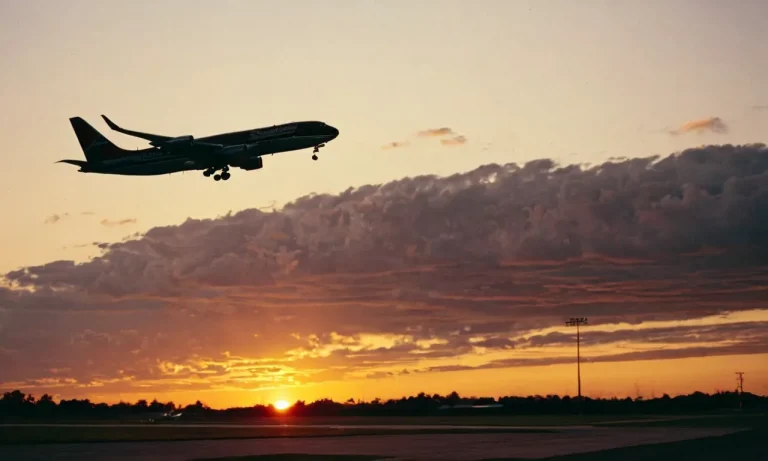Avoiding Traffic Times In Atlanta In 2023
Driving in Atlanta can be frustrating with its notorious traffic congestion. Knowing the best times to avoid traffic can help you better navigate the city and avoid getting stuck for hours in gridlock.
If you’re short on time, here’s a quick answer: generally avoid the roads between 7-10am and 3-7pm, as these are the peak commute times. Fridays tend to be the worst.
In this comprehensive guide, we will provide you details on Atlanta’s traffic patterns, highlight corridors and intersections that frequently get clogged, and offer tips on the best times and routes for avoiding traffic jams throughout the day.
Understanding Atlanta’s Traffic Patterns
Atlanta, the bustling city known for its vibrant culture and thriving economy, unfortunately, also has a reputation for its notorious traffic. Navigating through the city’s busy streets can be quite a challenge, especially during peak hours.
To help you avoid the frustration of being stuck in traffic, it is essential to understand Atlanta’s traffic patterns. By familiarizing yourself with the city’s rush hours, Friday traffic, and congestion around events and venues, you can plan your journeys more efficiently and save precious time.
Morning and Evening Rush Hours
Like most major cities, Atlanta experiences heavy traffic during morning and evening rush hours. Commuters heading to work or returning home typically face congestion during these peak times. The morning rush hour in Atlanta generally starts around 7:00 am and lasts until 9:00 am.
During this time, the roads leading into the city center, such as I-85 and I-285, tend to be congested. Similarly, the evening rush hour in Atlanta typically begins around 4:30 pm and lasts until 6:30 pm.
If possible, it is advisable to plan your commute outside of these peak hours to avoid the gridlock.
Friday Traffic
Friday afternoons in Atlanta can be particularly challenging for commuters. As the workweek comes to a close, many people are eager to start their weekend, leading to heavy traffic on the city’s major highways.
To avoid getting stuck in the Friday traffic, consider adjusting your schedule by leaving earlier or later in the day. Alternatively, you could explore public transportation options, such as MARTA, Atlanta’s rapid transit system, which can help you bypass the congestion and enjoy a stress-free journey.
Traffic Around Events and Venues
Atlanta is home to numerous events, concerts, and sports games throughout the year, attracting large crowds from both residents and visitors. When these events take place, traffic around the venues can become extremely congested.
If you’re attending an event, it’s important to plan your route in advance and allow extra time for potential delays. Checking the event’s official website or local news sources for any traffic updates can also be beneficial.
Additionally, considering alternative transportation options like ridesharing or carpooling can help alleviate traffic congestion around popular event locations.
Atlanta’s Worst Bottlenecks and Traffic Hotspots
Downtown Connector
The Downtown Connector is one of Atlanta’s most congested highways, carrying over 248,000 vehicles per day. This 14-lane freeway connects the downtown area with the city’s northside neighborhoods. However, its high volume combined with closely-spaced interchanges and ramps often leads to standstill traffic.
According to the latest data, the southbound Downtown Connector had an average speed at rush hour of just 14 mph in 2022. The northbound side fared slightly better at 18 mph. Compare that to the speed limit of 50 or 55 mph and you can see why this stretch of I-75/85 is infamous!
😩 Some common trouble spots along the Downtown Connector include:
- The I-20 interchange
- The Martin Luther King Jr. Drive exit
- The Edgewood Avenue entrance ramp
So when’s the best time to avoid this traffic madness? Data shows congestion starts building after 2 pm going northbound and 3 pm going southbound. It doesn’t ease up until after 7 pm. Plan accordingly! ⏰
Spaghetti Junction
Ah yes, Atlanta’s Spaghetti Junction – perhaps the most appropriately named interchange ever. 🍝 This towering mass of concrete connects I-75, I-85 and I-285 on the city’s northeast side. With 15 major roads intersecting, navigating its web of on-ramps and off-ramps leaves many drivers’ heads spinning!
On average, nearly 245,000 vehicles pass through daily. Accidents frequently occur due to its unusual left-hand exits and inadequate merge lanes. In fact, Spaghetti Junction sees 350-400 crashes a year, per Georgia DOT data.
Congestion builds during both morning and evening commutes, with speeds dropping below 35 mph on I-85.
For a smoother drive, try avoiding Spaghetti Junction between 7-9 am and 4-7 pm if possible. And pay extra attention to those funky exits! 👀
I-285 and Ga-400 Interchange
Rounding out Atlanta’s traffic trouble trio is the I-285 and Ga-400 interchange, lying 20 miles north of downtown. This epic merging of two busy highways funnels traffic to/from the city’s northern suburbs. On average, 250,000 cars pass through daily.
The converging traffic flows cause significant slowdowns here. In fact, data shows southbound delays can add 30 extra minutes to drives during evening rush. Northbound isn’t much better, with average speeds of 36 mph. 🐢
Delays typically start after 2 pm heading southbound and build heavily between 4-7 pm. For northbound, the worst congestion happens from 6:30-9 am. Consider taking alternate routes or allowing extra time if traveling through during peak periods.
Tips for Avoiding Traffic in Atlanta
Adjust Work Hours
One effective way to avoid traffic in Atlanta is by adjusting your work hours. Rush hour in Atlanta typically occurs between 7:30 am and 9:30 am in the morning and between 4:30 pm and 6:30 pm in the evening.
By starting your workday earlier or later, you can bypass the peak traffic times and have a smoother commute. Talk to your employer about flexible work hours or consider negotiating a schedule that aligns better with your desired commute times.
Use Alternate Routes and Apps
Another strategy for avoiding traffic in Atlanta is to use alternate routes and traffic apps. Instead of relying solely on main highways and interstates, consider taking backroads or side streets that can help you bypass congested areas.
Additionally, there are several traffic apps available that provide real-time updates on traffic conditions, accidents, and road closures. These apps can help you plan your route more effectively and avoid heavily congested areas. Some popular traffic apps include Waze, Google Maps, and INRIX.
Take Public Transit When Possible
Public transit can be a great option for avoiding traffic in Atlanta. The Metropolitan Atlanta Rapid Transit Authority (MARTA) offers bus and rail services throughout the city and surrounding areas. By taking advantage of public transit, you can avoid the stress of driving in traffic and reduce your commute time.
Plus, using public transit is an eco-friendly alternative that helps reduce the number of cars on the road. Check out MARTA’s website at www.itsmarta.com for more information on routes, schedules, and fares.
By adjusting your work hours, utilizing alternate routes and traffic apps, and taking advantage of public transit, you can significantly reduce your chances of getting stuck in traffic in Atlanta. Remember to plan ahead and stay informed about current traffic conditions to ensure a smooth and stress-free commute.
Outlook for Improving Atlanta’s Traffic Issues
Atlanta has long been notorious for its traffic congestion, causing frustration and delays for its residents and visitors alike. However, there is hope on the horizon as the city is actively working on various initiatives to alleviate this issue and improve the overall traffic situation.
With a combination of infrastructure expansion plans and efforts to promote public transit and alternative modes of transportation, Atlanta aims to create a more efficient and accessible transportation system.
Infrastructure Expansion Plans
One of the key strategies in tackling Atlanta’s traffic problem is through infrastructure expansion. The city has recognized the need to invest in its roadways and transportation infrastructure to accommodate the growing population and increasing number of vehicles on the road.
Several major projects are already underway or in the pipeline to address this issue.
For instance, the Georgia Department of Transportation (GDOT) has plans for expanding and improving major highways such as I-285 and I-75/85. These projects involve widening lanes, adding new exits, and implementing intelligent transportation systems to better manage traffic flow.
Additionally, the city is investing in the construction of new roads and bridges to provide alternative routes and alleviate congestion in heavily trafficked areas.
Moreover, Atlanta is also focusing on enhancing its public transportation infrastructure. The Metropolitan Atlanta Rapid Transit Authority (MARTA) is expanding its rail and bus network, with new stations and routes being added to provide more convenient options for commuters.
This expansion aims to encourage more people to utilize public transit, reducing the number of cars on the road and easing congestion.
Promotion of Public Transit and Alternatives
In addition to infrastructure improvements, Atlanta is actively promoting the use of public transit and alternative modes of transportation to reduce reliance on cars. The city recognizes that encouraging people to choose these options can significantly alleviate traffic congestion and reduce the environmental impact of transportation.
Efforts are being made to improve the accessibility and affordability of public transit. MARTA is working on enhancing its services, including increasing frequency and extending operating hours. Additionally, the city is exploring innovative solutions like bike-sharing programs and electric scooter rentals to provide convenient and eco-friendly transportation alternatives for short-distance trips.
Furthermore, Atlanta is embracing smart technology to improve traffic management. Intelligent transportation systems are being implemented to monitor traffic conditions in real-time and adjust signal timings accordingly.
This technology helps to optimize traffic flow and minimize congestion at peak hours.
Conclusion
As the Atlanta metro continues to grow rapidly, dealing with traffic headaches will remain a fact of life. However, with some planning around known busy corridors and times of day, as well as tapping technology to find faster routes, you can minimize time spent in congestion.
Avoid peak hours whenever possible, stay patient, allow extra time for commutes just in case, and consider transit options. With the right mindset and tools, Atlanta’s traffic doesn’t need to halt your productivity and sanity.








